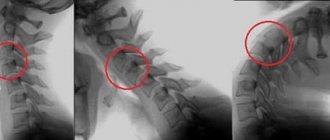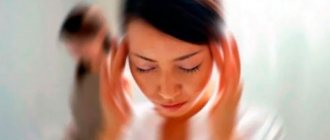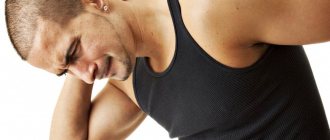Many of us are faced with the problem of neck pain and the inability to find adequate treatment for the symptoms of cervical osteochondrosis. Often the pain is accompanied by signs of VSD and panic attacks. Today it is customary to attribute all problems associated with VSD and cervical osteochondrosis to an unhealthy sedentary lifestyle, constantly spending time at the computer and on the phone. But what should we do if our whole life: work and a considerable part of our leisure time is connected with PCs and gadgets? Accept that we will have to take painkillers for the rest of our days, and that our pain, VSD and panic attacks are incurable? Or radically change your usual lifestyle? Modern neurologists are confident that such extreme measures are not at all necessary, and that modern medicine has found methods to combat VSD and panic attacks in cervical osteochondrosis.
So, if you are worried about neck pain and panic attacks with cervical osteochondrosis, then before choosing the appropriate treatment, you need to understand: why do neck pain and other symptoms attributed to cervical osteochondrosis occur, and why do panic attacks occur?
VSD and cervical osteochondrosis – what to treat?
Are you worried about neck pain? Against the background of constant pain, have you developed increased anxiety, weakness, tearfulness, insomnia and sensitivity to changes in atmospheric pressure? Or maybe you are already experiencing unexpected attacks of rapid heartbeat, numbness in the arms and legs, panic attacks and other symptoms of VSD and cervical osteochondrosis?
If you come to the doctor with such complaints, then most likely you will be diagnosed with “cervical osteochondrosis” and will be recommended to move more, do exercises, undergo a massage course, and if you have complaints of panic attacks with cervical osteochondrosis, you will definitely be prescribed medication.
In addition, if a person is bothered by the above symptoms, then along with and even instead of a diagnosis of osteochondrosis, the patient may be given VSD (vegetative-vascular dystonia), because the symptoms of the two diseases suspiciously coincide.
If you become the unfortunate owner of both diagnoses, then the number of pills you use will double. But will all these methods help get rid of constant pain and panic attacks with cervicothoracic osteochondrosis? Ultimately, many patients discover that they are “incurable.”
Therefore, before taking medications “for all diseases,” you should ask a number of logical questions: what comes first and what exactly needs to be treated – VSD and panic attacks, or cervical osteochondrosis? Why are the symptoms the same, but the treatment is different? How to distinguish VSD and cervical osteochondrosis? We will try to find answers to all these questions.
Symptoms of VSD from osteochondrosis in adults
Osteochondrosis and VSD symptoms are largely similar. These are severe headaches and muscle pain, disruption of innervation and sensitivity. But in most cases, symptoms of VSD in adults from osteochondrosis have a number of distinctive features:
- headaches and dizziness can occur only in case of exacerbation of the degenerative dystrophic process in the area of the intervertebral discs;
- during periods of remission, there is a danger of a sudden development of a panic attack against the background of a transient cerebrovascular accident;
- the increase and decrease in blood pressure directly depends on the degree of tension of the muscle fibers in the area of the neck and collar area;
- sleep disturbances, decreased mental performance increases as dystrophy of the intervertebral discs in the cervical spine develops;
- A secondary decrease in hearing and visual acuity may develop.
When headaches of muscle and emotional tension occur, posterior vertebral artery syndrome and arterial hypertension should always be excluded. It is also important to carry out differential diagnosis in order to exclude the risk of atherosclerosis of cerebral blood vessels.
VSD and panic attacks are disguised as cervical osteochondrosis.
VSD (vegetative-vascular dystonia) is one of the most tricky diseases. VSD and accompanying panic attacks are often disguised as cardiovascular, mental and other health problems. Vegetative-vascular disorder is associated with disturbances in the functioning of the autonomic nodes of the nervous system. These nodes (ganglia) are responsible for the normal functioning of almost all functions of our body: blood circulation, respiration, digestion, reproduction, excretion, metabolism and growth. Therefore, if there is a malfunction in their work, then a general malaise occurs, the variety of components of which ranges from headaches to disorders of the gastrointestinal tract, from mild weakness to a state of loss of consciousness. With VSD and panic attacks, a person does not understand what exactly is hurting him, and numerous examinations do not reveal any pathologies.
In addition, vegetative nodes are located throughout the body, and if they are unhealthy, then a person immediately feels tension or pain in the very part of the body where the unhealthy node is located. That is, if the nerve node in the cervicothoracic region does not work correctly, then first of all this will affect the muscles of the neck. And the first thing the patient will think about is “cervical chondrosis.”
Therefore, if you have a sore neck or are already experiencing panic attacks due to cervical osteochondrosis, then the problem is precisely that VSD, panic attacks and other symptoms are disguised as the so-called “cervical osteochondrosis.” Surprisingly, even such a common component of VSD as panic attacks is beginning to be misinterpreted as a sign of problems with the spine.
Understanding how the autonomic nervous system works also explains why neck pain typically occurs long (perhaps several years) before panic attacks occur. And with the development of panic disorder, patients often complain that neck pain (“cervical chondrosis”) begins to bother them right before a panic attack!
Now it becomes clear why outdated methods of treating cervical osteochondrosis and panic attacks do not bring the long-awaited results, and people live for years with symptoms of cervical osteochondrosis and panic attacks! It’s just that the treatment is aimed completely at the wrong area where it should be - at cervical osteochondrosis and the spine, and not at the VSD and the nervous system.
Danger of disease
If instability of the cervical vertebrae does not respond to timely treatment, the disease becomes chronic. It accelerates the development of diseases such as osteochondrosis. And this subsequently leads to intervertebral arthrosis. Severe pain begins to bother a person every time he tries to lift heavy objects or tries to bend his body.
Without proper therapy, migraines intensify, groundless irritability appears, and sleep disturbance occurs. Subsequently, problems arise with coordination of movement, vision and hearing. A person is constantly worried about drowsiness. Therefore, you should not start such a problem, since treatment in the initial stages always gives a positive result.
The diagnosis of cervical osteochondrosis is a myth.
Competent doctors know that the diagnosis of cervical osteochondrosis is one of the most persistent myths in medicine. And those who are less knowledgeable blame a great many problems on osteochondrosis, including panic attacks and symptoms of VSD.
Scientists have long discovered that osteochondrosis is a natural process of aging of the body. Even teenagers have signs of osteochondrosis on x-rays!
We inherited osteochondrosis from our ancient ancestors homo erectus (homo erectus), this is a natural consequence of the evolution of our species and the acquired ability to walk upright.
In fact, osteochondrosis itself does not contribute to the development of VSD and panic attacks and does not give rise to any pronounced clinical complaints. Even neck pain is not a sign of osteochondrosis! Not to mention other symptoms that are attributed to the diagnosis of cervical chondrosis.
What causes panic attacks, neck pain, and other symptoms that are so often attributed to cervical osteochondrosis?
Neck pain and panic attacks - what is the reason?
Let's take a closer look at the reasons why not only panic attacks actually occur with cervical osteochondrosis, but also neck pain.
Firstly, as we found out, the root cause of the disease lies precisely in the disorder of the autonomic nervous system, that is, in the VSD. And cervical osteochondrosis has nothing to do with it.
What happens when the functioning of the autonomic nodes of the nervous system is disrupted? Symptoms such as pain and tension in the neck occur due to muscle hypertonicity, that is, due to persistent muscle spasm in this part of the body. And the cause of the spasm is the excessive production of the neurotransmitter hormones adrenaline and noradrenaline, which are localized precisely in the autonomic nodes of our nervous system.
All other symptoms of cervical chondrosis and panic attacks (tachycardia, headache, numbness of the limbs, fatigue, insomnia, etc.) are standard signs of VSD and have the same causes. [More details: All symptoms and signs of VSD] The fact is that adrenaline and norepinephrine bring our entire body into a state of readiness to “start”. This state is adequate only in extreme situations. In other cases, it only depletes the reserves of our body and our psyche, which leads to nervous breakdowns and panic attacks.
Panic attacks when diagnosed with cervical osteochondrosis are a very common complaint. This is the second “unbearable” symptom of osteochondrosis after back and neck pain. It also happens that a person does not pay attention to muscle pain for a long time and considers it an integral part of his life, and focuses on the disease only when he is overcome by an inexplicable animal fear, fear of death, a condition close to a heart attack - a panic attack. It was then that it turned out that the first sign of the development of a vegetative-vascular disorder was muscle pain, which amounted to “cervical chondrosis” and which led to panic attacks.
Reviews about the treatment of vertebral displacement
Reviewed by Guvna Natalya 2018-07-02
My 10-year-old son had an unfortunate fall from a bicycle, resulting in a displacement of the cervical vertebrae.
Headaches began to appear, various massages were given, it became a little easier, but not for long. I found out about the osteopathic doctor Natalya Gennadievna Lazareva. I took my son and started treatment. After 3 months, all symptoms disappeared and vision was restored. I will now recommend her to everyone. Wonderful doctor! Thanks her! You can find other reviews here
Cervical osteochondrosis, VSD and panic attacks. Treatment.
People with VSD and panic attacks due to cervicothoracic osteochondrosis often do not know where and how it is treated. Patients undergo courses of massage, acupuncture, psychotherapy, take courses of medications, etc. But at best, it only provides temporary relief from the symptoms of muscle tension and panic attacks. It is important to understand that with “cervical osteochondrosis”, VSD and panic attacks, the symptoms of pain in the neck and back are caused by persistent muscle spasm of the deep muscles of the neck, which the massage therapist’s hands cannot reach, and therefore no massage can solve the problem. And the root cause of pain and panic attacks with VSD and “cervical osteochondrosis” will not be eliminated.
Since the cause of muscle pain and panic attacks during VSD is actually not related to cervical osteochondrosis, treatment should be aimed at the nervous system. The impact of the treatment must be quite deep and powerful and at the same time very careful and precise. Among modern methods of traditional medicine, there is a unique technique that meets these requirements - laser treatment: intravenous laser therapy with red or blue lasers and infrared laser therapy of the skin projection of excited autonomic ganglia.
One of the few places that can offer such treatment and where they have been effectively helping to get rid of panic attacks, VSD and “cervical osteochondrosis” for more than 20 years is the Clinical Center for Autonomic Neurology. The clinic's doctors are qualified neurologists-vegetologists who specialize in the treatment of VSD and panic attacks. If you are diagnosed with “cervicothoracic osteochondrosis”, you can contact us, we will conduct a thorough diagnosis of the state of your autonomic nervous system, and treatment will be aimed specifically at eliminating the source of the disease, that is, returning the nervous system to harmonious functioning, which will relieve you of all symptoms cervical osteochondrosis, VSD and panic attacks.
Treatment
A disease such as instability of the cervical vertebrae is treated with conservative methods or through surgery. At the Noosphere clinic, specialists will be able to select a comprehensive treatment that will help get rid of pain in the neck, which appears due to displacement of the vertebrae. Our doctors help the body get stronger and the spine regain its former stability.
The full therapeutic course consists of the following procedures:
- Resonance wave UHF therapy
Resonance wave therapy is a method of therapeutic effects on the aquatic environment of the body with low-intensity, high-frequency electromagnetic waves.
- Fermatron injections
Fermatron intra-articular injections are an effective method of treating various diseases of the musculoskeletal system by introducing a drug (chondroprotector) into the affected joint.
- Rehabilitation on the Thera-Band exercise machine
Treatment of the spine and joints using the Thera-Band simulator will restore limb mobility in a short period of time without expensive treatment in specialized sanatoriums.
- Block of joints and spine
Joint blockade is a type of drug treatment of the spine and joints aimed at relieving acute pain, inflammation and muscle spasms.
- Drug treatment
Drug treatment of joints and spine at the Noosphere clinic is used in a wide range and in combination with physiotherapy. Intra-articular injections, blockades and droppers.
The therapeutic course is selected individually in each case. This allows us to take into account the characteristics of the patient, his age and the very degree of displacement of the vertebra. Treatment usually takes up to six weeks, but this will depend on the severity of the disease.
At the Noosphere clinic, instability of the cervical vertebrae is treated using kinesiology. As a result, the displaced vertebra returns to its original place without any pain, the discomfort disappears, and the muscles become stronger. Thanks to spinal traction during kinesiotherapy sessions, the vertebrae themselves return to their normal position. Due to acupuncture, unpleasant spasms are eliminated, and hirudotherapy enriches the affected areas with oxygen and stimulates blood circulation.
If the mobility of the vertebrae has become advanced, the patient is asked to wear a special neck brace. It makes it possible to hold the vertebrae in their natural state, as well as support the head. Our specialists will help you decide on this device and calculate the duration of its wearing.
After the treatment is completed, the patient is given a manual containing a list of selected recommended exercises that help strengthen the neck muscles. The patient continues to consult with the attending physician throughout the year.









